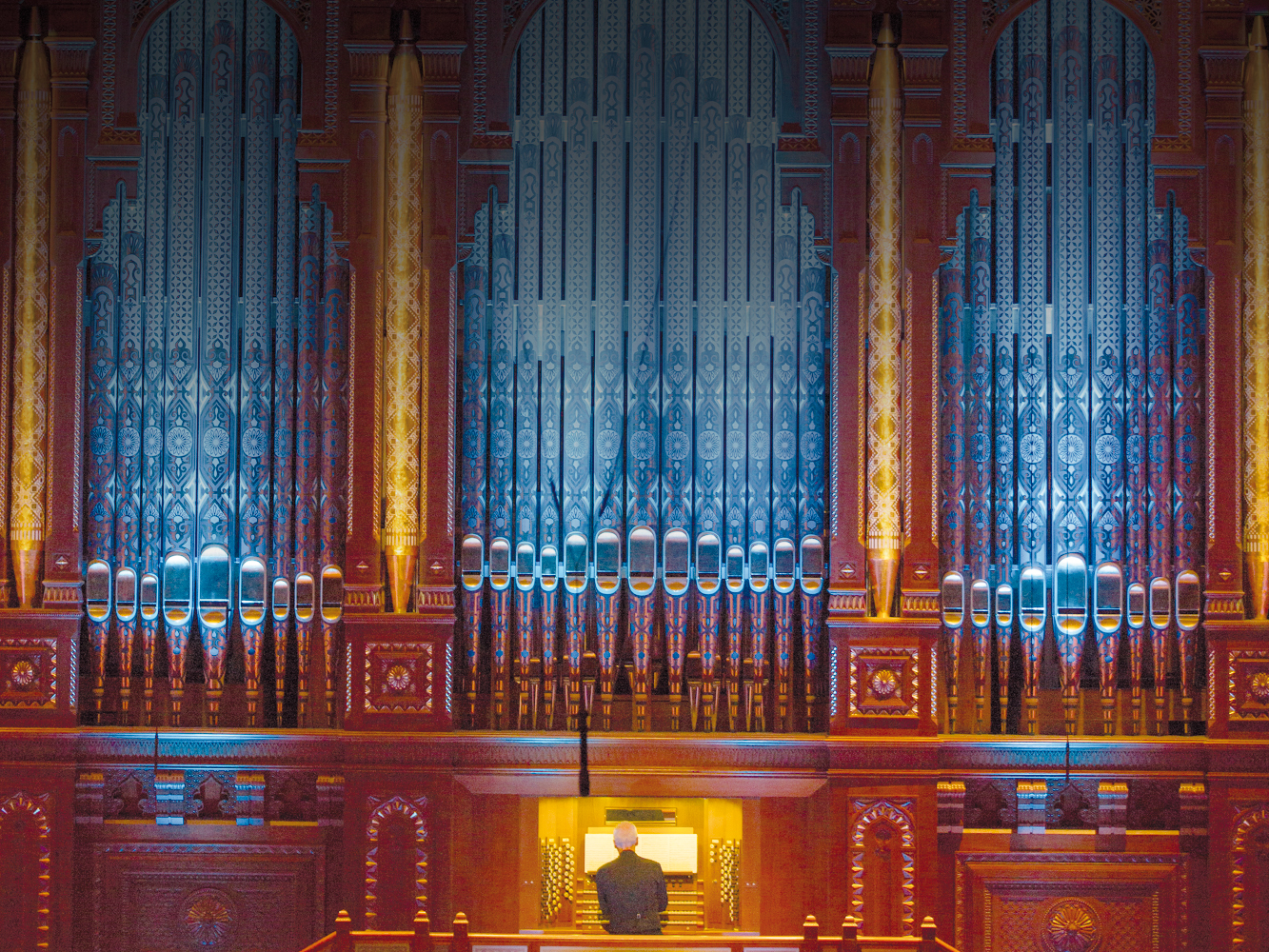

By Georgina Benison — On Saturday night, the auditorium at The Royal Opera House Muscat was transformed into a magnificent European Concert Hall, stretching across four eras in musical history. The massive pipe organ, containing 4,542 pipes reigned supreme as King of instruments in an unforgettable annual concert, delighting the audience. The performance, subtitled The Pipe Organ Through the Ages, began the Baroque period with a solo recital of that most recognisable and iconic of pieces, J.S.Bach’s, “Toccata and Fugue in D minor”, with Ian Hockley in the driving seat. It was perfectly executed with dazzling flourishes, and an impressive pedal entry of the Fugue theme which impressed those lucky enough to see the footwork. It presented the custom-built Klais instrument in its vast breadth of musical colour and dynamics.
From here Ian Hockley – the mastermind behind the programme – transferred to a smaller chamber organ amid the Kur-Sinfonie-Orchester from Bad Nauheim in Germany under the baton of British conductor, Steven Lloyd-Gonzalez. They were joined by guest solo oboist, Martine Varnik and ‘Cellist, Attila Hundol, for Zipoli’s “Adagio” – a tranquil piece of sublime string playing with haunting oboe melodies and a moving baroque ‘cello line, underpinned by barely-heard organ chords.
The Baroque section concluded with a thrilling organ concerto, Bach’s “Sinfonia in D” with Professor Roland Dopfer on the House Organ in a thrilling virtuoso ‘moto perpetuo’ performance, leading to a bold brass climax with some stunning trumpet fanfares. Pitting such a huge instrument, set at the back of the stage, against the immediacy of an orchestra at the front can cause some ensemble challenges. The conductor needs to be at the top of his game to ensure the two sonorities are married as seamlessly as possible. This was apparent in this fiendishly difficult concerto.
Roland Dopfer continued his recital with a delicate, tender piece from Mozart’s 1791 ‘Clock Organ’ oeuvre, a delightful “Andante in F” which piano students would instantly recognise as a Mozart Sonata with Variations. It featured the ‘Flute Qaboos’ stop, especially designed for His Majesty and which fills the hall with a warm, watery-flute sound.
In an unusual and unexpected item, the house organ, played by Professor Dopfer was paired with Hockley again on the chamber organ, in a relatively unknown 18th century work, Italian composer Lucchinetti’s “Concerto for two Organs” in two movements. What might have been perceived as an unequal dialogue proved perfectly balanced as the larger instrument displayed its subtle timbre against the distinctly brighter tones of the smaller, giving an extremely attractive diversion in a popular style.
The first half of the concert concluded with the orchestra returning to the stage for Mozart’s exciting ‘miniature symphony’ in barely four minutes, exploring the broad palette of orchestral colours available in a Classical world.
If the first half of the programme was magnificent, the second half was an exciting and dramatic tour-de-force of the Romantic and modern eras of organ compositions. Its eclectic diversity jumped from the page and opened with the youthful Camille Saint-Saens’ 1857 lively “Fantasia in E flat” for solo organ.
This was followed by the quintessentially English sound of Edward Elgar’s string orchestra with harp and sub-voce organ, with sonorous washes of rich colour in his 1914 “Sospiri” (sighs), a single movement piece which was breathtakingly beautiful.
In dramatic contrast came the “March Fantasie for Organ and Orchestra” by the now nearly forgotten French Romantic organist-composer, Felix-Alexandre Guilmant. We had a foretaste of this rarely heard 1875 concerto in the Organ Symposium performance on Thursday evening, when Dr Winfried Boenig presented a section of the solo organ version, giving a hint of the rich importance of Guilmant’s contribution to the repertoire. Tonight the orchestra was augmented by brass members of the Royal Guard of Oman, and two harps which were beautifully dominant throughout the piece with their distinctively romantic flavour and lush rippling harmonies. The organ gradually asserted itself until the animated Finale of massive proportions.
Excited anticipation was building as we moved into a contemporary vein with Keith Emerson (of Emerson, Lake and Palmer)’s 1970 celebration of The Royal Festival Hall, London’s organ in, “The Three Fates”, a spectacular triptych for pipe organ and three grand pianos. The composition depicts the Three Fates of Destiny from Greek mythology, opening with intense full organ, played brilliantly by Justin Bischof, in Bartok-like chords. It was challenging yet accessible to those with open minds and 20th century ears. The second Fate was played by Ian Hockley on the house Steinway in a variety of moods he describes as “a musical language that is reflective, jazzy, improvisational and virtuosic”. It was also fiendishly demanding yet arresting in its performance, a tribute to Hockley’s stamina and versatility that evening. The ‘Atropos’ third section was for the full ensemble, a pounding crescendo of interlocking riffs and ostinatos with percussion accompaniment. This was a climax in tension and sound, not least because the two pianists were familiar Omani ROSO musicians. I recall Jokha al Naabi’s technique in her debut performance as soloist in Shostakovich’s “Piano Concerto no.2” at the Al Bustan Palace auditorium last year, and writing then, I hope to hear more from her. Well, we have now and along with Rashid Salim al Rashidy it is wonderful to see Omani musicians on centre-stage.
The evening concluded with another English sound, the often neglected 1954 “Concerto for Organ and Orchestra” by Sir Malcolm Arnold, written for the opening of the Royal Festival Hall organ, in Neo-Baroque style with trumpet phrases recalling the splendour of that era. In three movements, the work was theatrical and brought the concert to a rousing, jubilant climax.
The programme was a superb achievement for the Opera House and was received to great acclaim by well-earned applause. I just can’t wait to learn what is on the menu for next year.
Oman Observer is now on the WhatsApp channel. Click here



